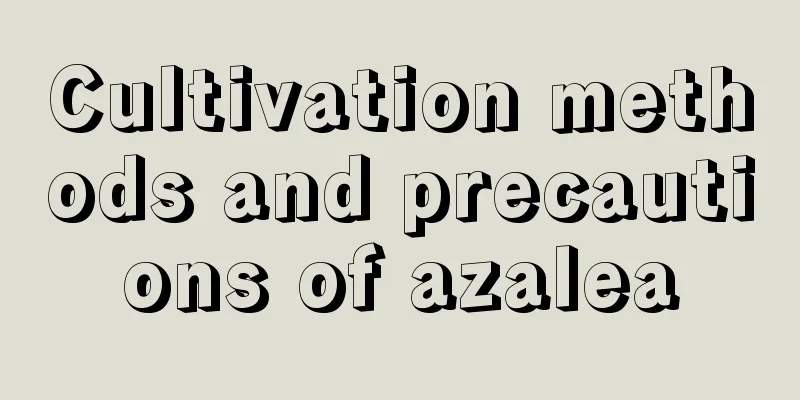Cultivation methods and precautions of azalea

1. SoilRhododendrons prefer loose, fertile, slightly acidic soil with good drainage and air permeability. It does not like heavy, alkaline soil. Therefore, we can mix leaf mold, peat soil and sand in a ratio of five to two to three as the soil for growing it. Before planting or transplanting, you can add a small amount of bone meal to the soil to increase the mineral content in the soil. 2. TemperatureThe most suitable temperature for azalea growth is 15-25℃. Try to let it grow within this temperature range in spring or autumn. When the temperature is relatively high in summer, you should pay attention to temperature control, the maximum should not exceed 32℃. When the temperature is relatively low in winter, you should move it indoors in time and keep the temperature above 5℃. 3. WateringWatering azalea is a technical job. If you water it too much, its roots will easily rot, and if you water it too little, its leaves will dry out. Generally speaking, we only need to keep the potting soil moist in early spring. In late spring and early summer, when it is ready to bloom, its water needs will increase greatly, so you need to water it a little more. In summer, when the temperature is too high, in addition to watering, you should also spray some water on the plants. In autumn, when the weather turns cooler, you need to control the water moderately and let the soil in the pot become slightly dry. After it goes dormant in winter, you should reduce watering. IV. Precautions1. Pruning. Rhododendrons grow relatively fast and can easily become very dense, which can result in many of the inner branches and leaves not seeing light and being unable to grow healthily. Therefore, it is necessary to trim it in time, which will not only make it look better, but also make it healthier. 2. Change the pot. The growth of azalea requires the consumption of nutrients in the soil. After one or two years, all the nutrients in the soil will be absorbed by it. At this time, you need to replace it with new soil rich in nutrient content so that it can continue to grow healthily. |
<<: Camellia cultivation methods and precautions
>>: Cultivation methods and precautions of Tiger Pilan
Recommend
These 5 kinds of flowers are most afraid of stuffiness in summer. If they are not ventilated, they will definitely die!
Succulent If you have been raising succulents for...
Is Jiangxi suitable for growing litchi trees? Can they survive in Jiangxi?
Planting lychee trees in Jiangxi Litchi can be gr...
When and how to plant sunflowers
Sunflower planting time Sunflowers are suitable f...
When is the best time to prune peony?
Peony pruning effect Pruning peony can help it bl...
How to propagate coral vine
Seed propagation Spring and summer are the best t...
What are the varieties of durian?
1. Golden Pillow The fruit of the golden pillow i...
How to grow mosquito repellent grass
fertilizer Mosquito repellent grass grows very fa...
Cultivation methods and precautions of potted baby's breath
1. Soil The most important thing for potted baby&...
Common species of Buddaria
Introduction of Buddaria Name: Buddaria Other nam...
How long does it take for the green radish to grow after repotting?
1. Duration of seedling acclimatization After rep...
When is garlic sprout harvested? In which month is it harvested?
Garlic sprouts harvest time The harvesting period...
How to change the soil of roses
When to change the soil of roses You can change t...
Can bougainvillea be planted at the doorstep?
Can bougainvillea be planted at the doorstep? You...
How to grow Magnolia arborvitae
1. Maintenance methods 1. Temperature: Magnolia g...
What trees are suitable for planting in the desert? What trees are suitable for planting in the desert?
Trees planted in the desert cannot be planted ran...









